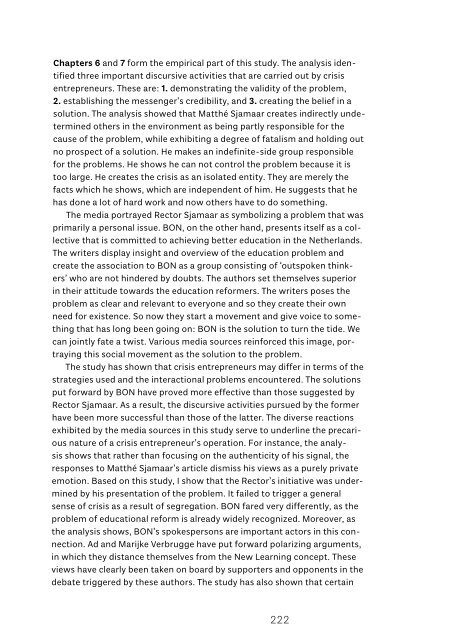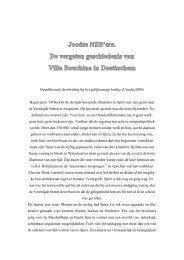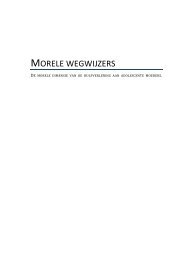Proefschrift Crisis in aantocht! - Onderzoek - Hogeschool Utrecht
Proefschrift Crisis in aantocht! - Onderzoek - Hogeschool Utrecht
Proefschrift Crisis in aantocht! - Onderzoek - Hogeschool Utrecht
You also want an ePaper? Increase the reach of your titles
YUMPU automatically turns print PDFs into web optimized ePapers that Google loves.
Chapters 6 and 7 form the empirical part of this study. The analysis identified<br />
three important discursive activities that are carried out by crisis<br />
entrepreneurs. These are: 1. demonstrat<strong>in</strong>g the validity of the problem,<br />
2. establish<strong>in</strong>g the messenger’s credibility, and 3. creat<strong>in</strong>g the belief <strong>in</strong> a<br />
solution. The analysis showed that Matthé Sjamaar creates <strong>in</strong>directly undeterm<strong>in</strong>ed<br />
others <strong>in</strong> the environment as be<strong>in</strong>g partly responsible for the<br />
cause of the problem, while exhibit<strong>in</strong>g a degree of fatalism and hold<strong>in</strong>g out<br />
no prospect of a solution. He makes an <strong>in</strong>def<strong>in</strong>ite-side group responsible<br />
for the problems. He shows he can not control the problem because it is<br />
too large. He creates the crisis as an isolated entity. They are merely the<br />
facts which he shows, which are <strong>in</strong>dependent of him. He suggests that he<br />
has done a lot of hard work and now others have to do someth<strong>in</strong>g.<br />
The media portrayed Rector Sjamaar as symboliz<strong>in</strong>g a problem that was<br />
primarily a personal issue. BON, on the other hand, presents itself as a collective<br />
that is committed to achiev<strong>in</strong>g better education <strong>in</strong> the Netherlands.<br />
The writers display <strong>in</strong>sight and overview of the education problem and<br />
create the association to BON as a group consist<strong>in</strong>g of ‘outspoken th<strong>in</strong>kers’<br />
who are not h<strong>in</strong>dered by doubts. The authors set themselves superior<br />
<strong>in</strong> their attitude towards the education reformers. The writers poses the<br />
problem as clear and relevant to everyone and so they create their own<br />
need for existence. So now they start a movement and give voice to someth<strong>in</strong>g<br />
that has long been go<strong>in</strong>g on: BON is the solution to turn the tide. We<br />
can jo<strong>in</strong>tly fate a twist. Various media sources re<strong>in</strong>forced this image, portray<strong>in</strong>g<br />
this social movement as the solution to the problem.<br />
The study has shown that crisis entrepreneurs may differ <strong>in</strong> terms of the<br />
strategies used and the <strong>in</strong>teractional problems encountered. The solutions<br />
put forward by BON have proved more effective than those suggested by<br />
Rector Sjamaar. As a result, the discursive activities pursued by the former<br />
have been more successful than those of the latter. The diverse reactions<br />
exhibited by the media sources <strong>in</strong> this study serve to underl<strong>in</strong>e the precarious<br />
nature of a crisis entrepreneur’s operation. For <strong>in</strong>stance, the analysis<br />
shows that rather than focus<strong>in</strong>g on the authenticity of his signal, the<br />
responses to Matthé Sjamaar’s article dismiss his views as a purely private<br />
emotion. Based on this study, I show that the Rector’s <strong>in</strong>itiative was underm<strong>in</strong>ed<br />
by his presentation of the problem. It failed to trigger a general<br />
sense of crisis as a result of segregation. BON fared very differently, as the<br />
problem of educational reform is already widely recognized. Moreover, as<br />
the analysis shows, BON’s spokespersons are important actors <strong>in</strong> this connection.<br />
Ad and Marijke Verbrugge have put forward polariz<strong>in</strong>g arguments,<br />
<strong>in</strong> which they distance themselves from the New Learn<strong>in</strong>g concept. These<br />
views have clearly been taken on board by supporters and opponents <strong>in</strong> the<br />
debate triggered by these authors. The study has also shown that certa<strong>in</strong><br />
222







